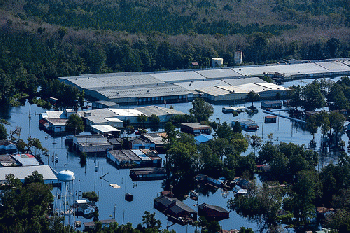Note (November 25): Hurricane Florence, one of the most powerful to ever
hit the Carolinas, made landfall on September 14. That same day the
powerful typhoon Mangkhut wreaked havoc in the Philippines. And in the
weeks since then, Hurricanes Michael and Willa, and Typhoon Yutu have
battered countries in or along the Atlantic and Pacific oceans and
caused at least 200 deaths, while massive global warming-fueled wild
fires have caused unprecedented death and destruction in California and
caused serious damage in other Western states.
In this five-part series on Hurricane Florence, we examine how the
capitalist-imperialist system has magnified the destructive impacts of
this (and similar) natural disasters, and how it's responded to them, as
well as the underlying and greatly intensifying crisis of global
climate change. We start looking at the radically different ways a
revolutionary socialist society would prepare and respond to Florence,
and other such natural disasters.1
How should a society produce its food? Shouldn't this be done in ways that are humane for the people--and animals--involved? That are safe and environmentally sustainable? And, among other considerations, shouldn't the whole process contribute to breaking down oppressive social divisions, not heightening them?
With this in mind, let's look at one part of the food chain: how pork is produced in North Carolina.
10 Million Pigs...10 Billion Gallons of Waste:
Industrial Hog Farms and Pig Manure "Lagoons"
North Carolina has 2,200 hog farms with some 9.7 million pigs, most raised on industrial factory farms where they're confined in large-scale pens, at close quarters. These hogs produce some 10 billion gallons of feces and urine each year. This toxic brew falls through slats in these pens to be collected and treated with chemicals, and then piped to one of the state's 4,000 open-air "lagoons"--man-made earthen pits, some as large as football fields.
These industrial farms and their lagoons pose health and environmental hazards in normal times. "This urine and fecal matter produces methane, ammonia gases, and so you can smell it. And what people say, it smells like rotten eggs, sometimes rotten collard greens or--it's just a terrible smell. And [people] have been forced off of their wells, because they were seeing remnants of the waste in their well waters by the coloring and the odors coming out of their well water," according to Naeema Muhammad, organizing co-director for the North Carolina Environmental Justice Network.2
A 2014 study linked air pollution from hog farms to increased rates of nausea, higher blood pressure, respiratory issues including asthma, and overall diminished quality of life. Nitrates associated with pig manure which leak or spill from these lagoons and have been found in groundwater have been linked to illness such as blue baby syndrome--when babies' skin turns blue due to dangerously low levels of hemoglobin in their blood. Living near a hog farm can even shorten lifespan according to a new Duke University study.3
These health and environmental dangers are made even worse by how these hog farms try to prevent their open-air cesspools from overflowing: they liquefy their pig manure and spray it onto nearby fields, which can also run off into rivers, streams, and groundwaters. (This is what some pig farms did as Florence approached in order to prevent their lagoons from overflowing or breaching.)
Who lives nearby these foul-smelling, environmentally hazardous hog factories? Disproportionately Black people, Latinos and Native Americans--who are 1.5, 1.39 and 2.18 times more likely to live within three miles of industrial hog farms than white people. Lumberton, which we described in part II of this series, is one of those towns.
"We're prisoners in our own home," one Black woman, whose family had lived on their property for nearly 100 years, told the Guardian.4
Hit By Florence, Lagoons Pour Poisonous Waste into Rivers and Waterways
The environmental and health hazards posed by North Carolina's hog farms and waste lagoons are heightened by their location: there are still at least 62 factory hog operations on North Carolina's eastern plain, which is increasingly hit by hurricanes and record flooding. And these factory farms store more than 200 million gallons of animal waste generated each year.
Hurricane Florence pummeled North Carolina with up to 36 inches of rain in four days, dumping a total of 8 trillion gallons of water.5 For two weeks, those rains gushed across the plains and down from mountains in the west, causing rivers to crest at record levels and some towns to flood.
Of the over 100 pig manure lagoons at risk of being breached or flooded, the Natural Resources Defense Council found that six lagoons suffered structural damage and 33 overflowed discharging huge amounts of hog feces. More than seven million gallons of hog sh*t escaped from two lagoons alone, fouling tributaries to two of North Carolina's largest rivers: the South River and the Northeast Cape Fear River.6
Over 5,000 pigs and 4.2 million farm chickens and turkeys were drowned or died during the storm and flooding, adding another potential biohazard to this horrid mix.
Why Do Industrial Hog Farms Remain in Flood Zones?
This Is What Happens When Competing Blocs of Capital--Not Humanity--Are in Control of Food Production
(Note: You can view every article as one long page if you sign up as an Advocate Member, or higher).





